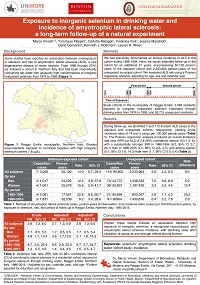Background: Some studies have reported an association between overexposure to selenium and risk of amyotrophic lateral sclerosis (ALS), a rare degenerative disease of motor neurons. From 1986 through 2015, we followed a cohort in Northern Italy that had been inadvertently consuming tap water with unusually high concentrations of inorganic hexavalent selenium from 1974 to 1985.
Methods: We had previously documented an excess incidence of ALS in this cohort during 1986-1994. Here, we report extended follow-up of the cohort for an additional 21 years, encompassing 50,100 person-years of the exposed cohort and 2,233,963 person-years of the unexposed municipal cohort. We assessed ALS risk using a Poisson regression analysis, adjusting for age, sex and calendar year.
Results: We identified 7 and 112 incident ALS cases in the exposed and unexposed cohorts, respectively, yielding crude incidence rates of 14 and 5 cases per 100,000 person-years. The Poisson regression analysis produced an overall incidence rate ratio (IRR) for ALS of 2.8 (95% confidence interval (CI) 1.3, 6), with a substantially stronger IRR in 1986-1994 (8.2, 95% CI 2.7, 24.7) than in 1995-2015 (1.5, 95% CI 0.5, 4.7), and among women (5.1, 95% CI 1.8, 14.3) than men (1.7, 95% CI 0.5, 5.4).
Conclusions: Overall, these results indicate an association between high exposure to inorganic selenium, a recognized neurotoxicant, and ALS incidence, with declining rates after cessation of exposure and stronger effects among women.
Keywords: selenium; amyotrophic lateral sclerosis; drinking water; cohort study; incidence

